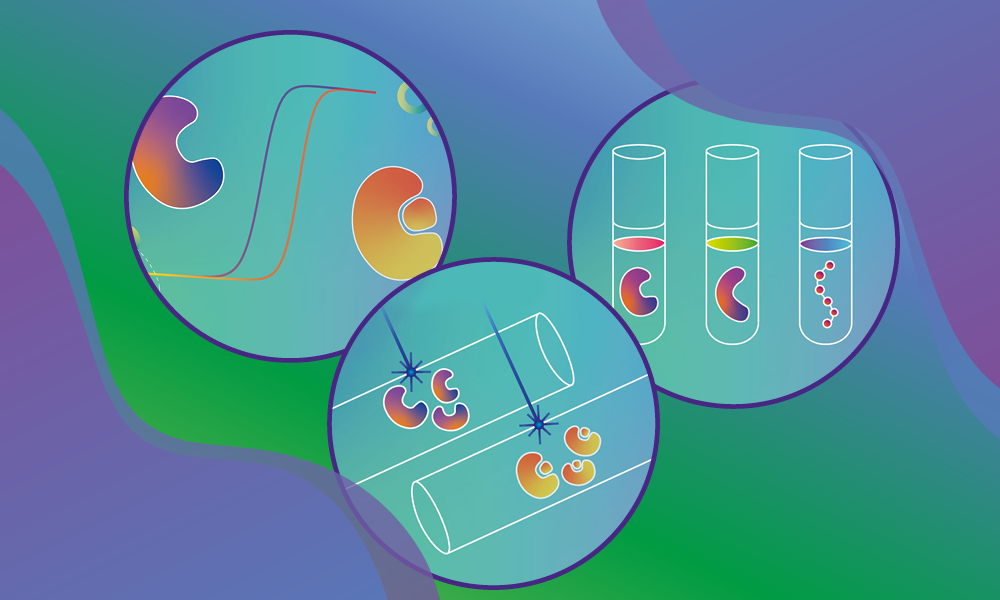EMBL Hamburg's Sample Preparation and Characterisation Facility has released an online platform for analysing data from biophysical experiments

EMBL Hamburg's García Alai Team has released eSPC, a freely available online platform for analysing molecular biophysics data from a range of experimental techniques. The tool enables scientists around the world to easily analyse their data without the need to travel to the laboratory where the data was generated.
All biological processes rely on interactions between molecules, such as proteins. Understanding the biophysical aspects of these interactions - for example, how strong and dynamic they are, and how they change in different conditions - is extremely helpful in many research fields, including structural biology, biomedicine, and biotechnology. Biophysical analyses can, for example, help to identify drug candidates that are most effective in binding their target.
Scientists perform biophysical analyses at dedicated facilities, such as the Sample Preparation and Characterisation (SPC) Facility at EMBL Hamburg and the Centre for Structural Systems Biology (CSSB). The SPC Facility offers a pipeline from the lab bench to the synchrotron beamlines, helping users to optimise and prepare their samples for structural studies. As well as accessing advanced equipment and expertise, users can get help from the facility team to analyse data. However, the team frequently faces the problem that the data can only be analysed using the software connected to the equipment and the facility.
"That means our users would need to be in the facility to analyse their data. This has been a hassle before, but during the 2020 lockdown, it made the work almost impossible," said María García Alai, Team Leader and Head of the SPC Facility. "Working from home mobilised us to build the eSPC analysis platform, and solve this problem for good. You could see this as a positive aspect of the lockdown."
The platform enables users to upload and analyse raw data from several experimental techniques: steady-state fluorescence spectroscopy, microscale thermophoresis, and differential scanning fluorimetry experiments. It consists of three modules. FoldAffinity quantifies how an interaction between two molecules can further stabilise them. MoltenProt helps to estimate how durable a protein is in different conditions. ThermoAffinity identifies how strongly two molecules, e.g. a protein and a drug, bind to each other.
"The platform was foreseen as an educational tool," explained García Alai. "We have implemented different biophysical theoretical models with tutorials that guide non-experts to assess the quality of their collected data, analyse the results, and produce publication-quality figures. We wanted this tool to be accessible to the whole community to push scientific discoveries forward."
To ensure the eSPC platform meets the needs of the scientific community, the García Alai Team collected several rounds of feedback from a group of users. Once the tool was made publicly available, Francesca Short, a researcher at Monash University in Australia, was one of the first users to test FoldAffinity.
"We used FoldAffinity to study how various molecules bind and influence bacterial proteins that contribute to antimicrobial resistance, a critical public health challenge of this century," said Short. "We could only do measurements using methods suitable for small amounts of protein, so it was great for us that FoldAffinity allows us to analyse data generated with these methods. We also liked that the output from eSPC was very comprehensive and easy to understand."
Looking ahead: the ARISE fellowship to strengthen collaboration
Positive feedback from users encouraged the García Alai Team to look into expanding the platform in the future. To do this, the team recruited Osvaldo Burastero in this year's ARISE programme. ARISE is the first fellowship that trains technology developers and engineers to advance technology and method development in life sciences and to learn how to lead service-providing research infrastructures.
Burastero will spend part of his fellowship at the Molecular Biophysics facility at the Institute Pasteur. The facility already works with the García Alai Team within MOSBRI, the pan-European consortium of biophysics facilities. There, he will get hand-on experience in a broad range of new techniques. He will use this knowledge to develop new modules for the platform that cover those techniques.
"For me, it is a great opportunity to work in the García Alai Team within the ARISE programme," said Burastero. "It lets me learn all the aspects of building scientific software, from the theory behind experiments to managing users. I'm excited to contribute to developing a platform that supports scientists around the world, and I look forward to new developments. I hope we can provide a data analysis platform that other research infrastructure for molecular-scale biophysics will recommend to its users!"
Scientific services are at the heart of EMBL's missions, and the SPC Facility's effort to meet the needs of the scientific community is a great example of that. The SPC Facility supports mainly structural biologists, but eSPC can serve as a bridge to interact with and support other scientific fields, fostering interdisciplinary research.






